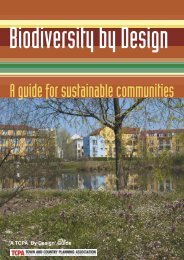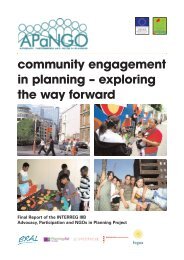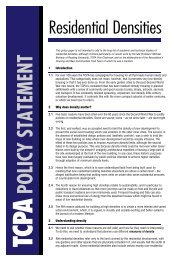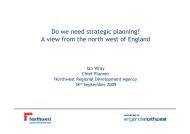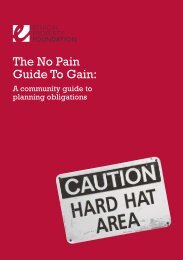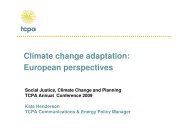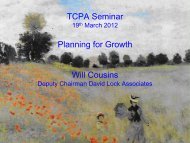Download Connecting England - Town and Country Planning ...
Download Connecting England - Town and Country Planning ...
Download Connecting England - Town and Country Planning ...
Create successful ePaper yourself
Turn your PDF publications into a flip-book with our unique Google optimized e-Paper software.
20 <strong>Connecting</strong> <strong>Engl<strong>and</strong></strong>create places which ‘offer people a decent home that they can afford, a community in which theywant to live <strong>and</strong> work, the choice to develop their skills <strong>and</strong> interests, access to public <strong>and</strong> excellentservices <strong>and</strong> the chance to get engaged in their community <strong>and</strong> make a difference’. 13 Implementingthe Sustainable Communities Plan requires spatial investment decisions to be taken at variouslevels from the national to the neighbourhood on a range of matters, including transport,economic development <strong>and</strong> settlement planning.Although it cannot st<strong>and</strong> alone from the ‘Sustainable Communities’ objectives, a matter of particularconcern is ensuring the provision of sufficient fit <strong>and</strong> affordable housing. At present almost a third ofall housing falls below the decent homes st<strong>and</strong>ard <strong>and</strong> 1.5million households live in social homes thatare not decent. In addition more than 1million vulnerable households, especially those comprisingolder people, live in privately-owned homes that are not decent, putting their health at risk.This is especially, but not exclusively, a problem of the northern towns <strong>and</strong> cities. Here are foundlarge surviving numbers of so-called by-law terraced housing from the era 1870-1914, which nolonger meet 21st century aspirations. Here too are found large concentrations of social housingfrom the great rebuild of the 1960s. These have not worn well <strong>and</strong> increasingly are rejected bytenants who have a choice. In the North West, in particular, large numbers of people havemoved out of the cities into new estates in the countryside, leaving huge tracts of ab<strong>and</strong>onedl<strong>and</strong> <strong>and</strong> sometimes ab<strong>and</strong>oned housing. The Government’s nine Pathfinder areas, all in theNorth or the Midl<strong>and</strong>s – Newcastle-Gateshead, Hull <strong>and</strong> East Riding, South Yorkshire,Birmingham-S<strong>and</strong>well, North Staffordshire, Manchester-Salford, Merseyside, Oldham-Rochdale,East Lancashire – are attempting to address this problem through judicious local combinations ofdemolition, rebuilding <strong>and</strong> rehabilitation, in a programme with a budget that will treble from£150million in 2004/05 to over £450million in 2007/08.The 2001 English House Condition Survey identified a clear dem<strong>and</strong> from the public for higherqualityhomes <strong>and</strong> neighbourhoods. A large majority of people did not consider that currenthousing developments were well designed. As a result, according to the New Homes MarketingBoard, only 36 per cent of the population will even consider new housing as an option. This,combined with the poor phasing of related infrastructure <strong>and</strong> social <strong>and</strong> community facilities,merely tends to reinforce <strong>and</strong> institutionalise NIMBY attitudes against new housing developmenton greenfield l<strong>and</strong> outside the cities.1.6 Rural Development13 Office of theDeputy PrimeMinister (2005)SustainableCommunities: People,Places <strong>and</strong> Property.London: TheStationery Office14 <strong>Country</strong>sideAgency (2004)Review of<strong>Country</strong>side Issuesin <strong>Engl<strong>and</strong></strong>.Cheltenham:<strong>Country</strong>side AgencyRural <strong>Engl<strong>and</strong></strong> may appear idyllic to the casual weekend visitor or holiday-maker. But it too isexperiencing cataclysmic change: ‘The economies of rural areas are increasingly dependent onregional, national <strong>and</strong> global business links rather than traditional patterns of rural trades.’ 14 Theseareas are experiencing a decline in the traditional primary sector <strong>and</strong> an expansion of the servicesector. They suffer from only small pools of appropriate labour, poor communications <strong>and</strong>accessibility, <strong>and</strong> a lack of critical mass for business support. Public spending on bus services inrural areas is typically about a third less in shire counties than in urban areas; people living inrural areas experience the most pressing problems of access to public <strong>and</strong> private services <strong>and</strong>facilities compared with those in urban areas.But simultaneously rural areas are increasingly affected by migration from urban areas,sometimes over very long distances, associated with new lifestyle patterns among affluent




